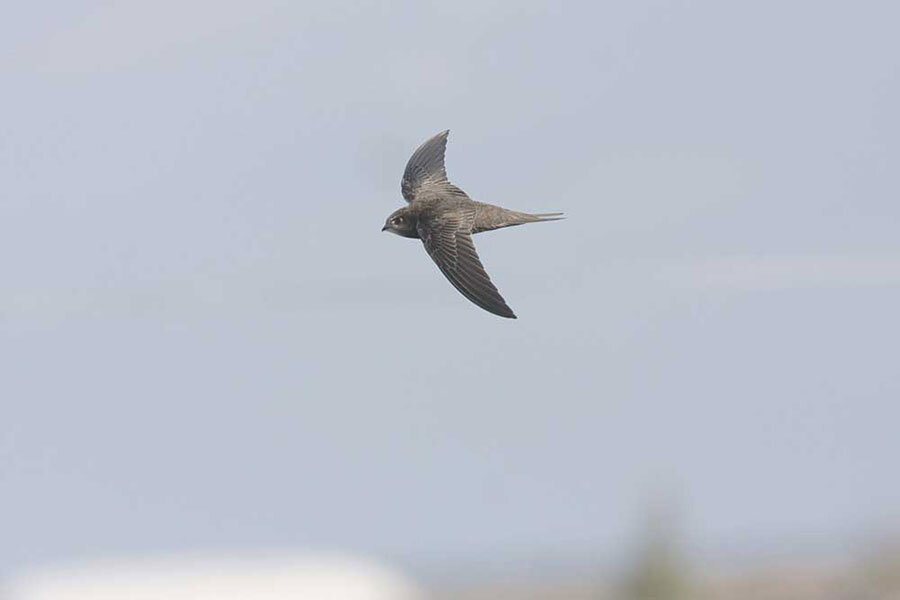Common swifts' airborne life: Eat, sleep, and mate without touching Earth
Loading...
A 10-hour flight can leave humans longing for solid ground beneath their feet, but for some birds that might not be the case – even after months, not hours, on the wing.
The common swift, Apus apus, spends 10 months of the year aloft, according to research published Thursday in the journal Current Biology.
This new study makes the bird a record-setter. Previous research had pointed to the Alpine swift, Tachymarptis melba, as being able to fly non-stop for some 200 days, 100 days less than the common swift. So this new research "extends the range that we know birds can fly," Niels Rattenborg, a researcher at the Max Planck Institute for Ornithology in Germany who was not involved in the study, tells The Christian Science Monitor.
"Humans didn't learn to fly until a little bit over 100 years ago, for a few seconds," study lead author Anders Hedenström, a professor of evolutionary ecology at Lund University in Sweden, tells the Monitor. "But evolution has come up with an organism that can spend almost their entire life airborne. I think that is absolutely fantastic."
And the air seems to be the animal's preferred environment.
"It's not a physical necessity to come down," Dr. Hedenström says. "I think it's more of an emergency thing." His team noted that a handful of individual birds landed to roost for a few nights during the winter months. But those instances were extremely rare, accounting for less than 1 percent of the non-breeding time, so the researchers chalked these roosting events up to stormy weather or other extreme conditions forcing the swifts to land.
The birds may prefer an aerial lifestyle because their bodies aren't built for efficient movement on the ground. With short legs and clumsy feet, swifts could be easy snacks for terrestrial predators.
But as fliers, the birds are adept and quick, Hedenström says. They can fly at top speeds of about 75 miles an hour, and their body plans allow them to coast on air currents without flapping.
So what are the animals doing up there for months at a time? Everything, Hedenström says.
The birds deftly catch insects in midair to munch on, so they don't need to land to get a snack. They can even mate in the air, adds Hedenström, although they come down to the ground to lay their eggs.
The one puzzle is sleep. All animals need to sleep, he says, so the swifts must have found some way to nod off safely on the wing.
A study of frigatebirds published earlier this year found that they could sleep while airborne. But these sleeping soarers only got about 42 minutes of sleep per day when they were aloft, says Dr. Rattenborg, who conducted the study. Perhaps the same is true for swifts, he says, but how much sleep they need is "really up in the air."
"We found that the frigatebirds sleep only when they're gliding, not when they're flapping," Rattenborg says. But when it comes to the swifts, "anything is possible. Maybe they can also sleep while they're flapping their wings," he says. "We simply do not know."
Hedenström and his team did observe a curious pattern in the birds' flight that might be a clue. Twice a day, at dawn and dusk, the swifts seem to flap a lot more than usual. These high-activity periods are then followed by flight with a lot less flapping. And the birds appear to do this every day.
This pattern is consistent with previous observations of the birds climbing to between one and a quarter miles and two miles in altitude. "We think they climb to high altitude at one time around dawn and one time around dusk," Hedenström says.
Although the team doesn't know why the birds are doing this, Hedenström suspects it might have something to do with sleep. Perhaps the swifts are climbing high enough to glide down in a long, slow nap.
"Ornithologists have long speculated about the possibility that common swifts could actually be airborne for their entire non-breeding period of up to 10 months," Hedenström says. In fact the idea had been formally suggested nearly 50 years ago.
But, Hedenström says, these speculations were merely conjectures based on circumstantial evidence. For example, he says, ornithologists hadn't observed the common swifts roosting in their tropical African wintering "grounds" in any significant number.
So, Rattenborg says, "this is the first study to actually demonstrate that swifts remain flying throughout most of the non-breeding season."
Hedenström and his team strapped little data loggers to the birds to monitor and record acceleration. These devices sensed when the birds were actively flying.
Common swifts have been known to live to the ripe old age of 20, and with all that flying, Hedenström said, one bird could make it to the moon and back seven times.








